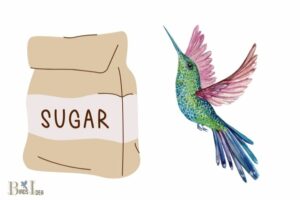How Cold Can Ruby Throated Hummingbirds Survive? 27°F!
Ruby-throated hummingbirds are resilient birds capable of withstanding cooler temperatures than one might expect.
They can survive in temperatures that drop to about 27°F (-3°C) by entering a state of torpor, which is a form of temporary hibernation that reduces their metabolic rate and conserves energy.
Ruby-throated hummingbirds, primarily found in North America, have developed a remarkable adaptation to cope with cold nights or unseasonable chills.
Torpor allows these birds to lower their body temperature and significantly decrease their heart rate, thus conserving energy when food resources are scarce or during cold snaps.
This means they can survive temperatures that are much colder than the tropical climates they are often associated with.
However, prolonged exposure to cold without the ability to feed and restore energy can be fatal, so they typically migrate to warmer climates during the winter season.
With an impressive survival adaptation like torpor, the ruby-throated hummingbird braves the occasional cold snap, a testament to the tenacity of these delicate yet hardy avian wonders.

Key Takeaway
Physiological Adaptations to Cold
During cold temperatures, ruby-throated hummingbirds employ physiological adaptations to maintain their body temperature and survive.
These small birds have a high metabolic rate, about 77 times that of an average human, which generates heat to keep them warm.
Additionally, they enter a state of torpor during cold nights, lowering their metabolic rate by 95% and dropping their body temperature significantly, conserving energy until the next day.
Their feathers also play a crucial role in insulation, trapping a layer of air close to their bodies to prevent heat loss.
Furthermore, they can shiver to generate extra heat when needed. These adaptations allow ruby-throated hummingbirds to survive in cold temperatures that would be lethal to other birds of their size.
Thermoregulation and Metabolism
With a metabolic rate approximately 77 times higher than that of an average human, ruby-throated hummingbirds effectively generate heat to maintain their body temperature during cold conditions.
This high metabolic rate is essential for their survival in cold environments as it allows them to maintain a body temperature of around 104 degrees Fahrenheit, even when external temperatures drop significantly.
To support this high metabolic rate, hummingbirds have an exceptionally efficient respiratory and circulatory system.
Their rapid breathing and heart rate enable them to supply oxygen and nutrients to their muscles, which is crucial for sustaining their high-energy lifestyle.
Furthermore, they can enter a state of torpor during extremely cold nights, where their metabolic rate and body temperature decrease significantly, helping them conserve energy until the temperature rises again.
Behavioral Responses to Low Temperatures
Ruby-throated hummingbirds employ various behavioral responses to cope with low temperatures, including entering a state of torpor to conserve energy during cold nights, regulating their body temperature through shivering and adjusting their metabolic rate, and seeking shelter by roosting and huddling together with other hummingbirds.
These strategies allow them to minimize heat loss and maintain their energy reserves, enabling them to survive in colder climates and harsh weather conditions.
Understanding these behavioral adaptations provides valuable insights into how these tiny birds manage to thrive in challenging environmental conditions.
Winter Torpor Strategies
How do ruby-throated hummingbirds adapt their behavioral responses to low temperatures during winter torpor?
Winter torpor is a crucial survival strategy for ruby-throated hummingbirds during cold temperatures.
When the ambient temperature drops, these birds enter a state of torpor, significantly reducing their metabolic rate and lowering their body temperature to conserve energy. This behavioral response allows them to survive cold nights when food sources are scarce.
The following table illustrates the key behavioral adaptations of ruby-throated hummingbirds during winter torpor:
| Behavioral Response | Description | Purpose |
|---|---|---|
| Entering torpor | Reducing metabolic rate and body temperature | Conserving energy and surviving cold nights |
| Seeking shelter | Finding protected roosting spots | Minimizing heat loss and exposure to the elements |
| Warming up | Shivering and sunning themselves | Regaining normal metabolic functions and body temperature |
These strategies enable ruby-throated hummingbirds to navigate the challenges of low temperatures during winter torpor.
Body Temperature Regulation
During prolonged exposure to low temperatures, ruby-throated hummingbirds exhibit behavioral responses to regulate their body temperature, ensuring their survival through a combination of physiological and environmental adaptations.
To combat the cold, these hummingbirds can enter a state of torpor, where their metabolic rate drops significantly, allowing them to conserve energy and maintain a lower body temperature.
Additionally, they have been observed to fluff their feathers to create insulating air pockets, reduce their body surface area by tucking their bill and feet into their plumage, and seek sheltered microhabitats to minimize heat loss.
Furthermore, hummingbirds may increase their food intake before cold nights to store energy and generate heat through digestion.
By employing these strategies, ruby-throated hummingbirds can effectively regulate their body temperature and survive in challenging cold environments.
Roosting and Huddling
To combat low temperatures, ruby-throated hummingbirds employ roosting and huddling as behavioral responses to conserve heat and maintain their body temperature.
Roosting involves finding sheltered and insulated locations to spend the night, such as dense vegetation or tree cavities, while huddling refers to the birds clustering together to share body heat.
This behavior helps them minimize heat loss and survive cold nights, especially during migration and in their wintering grounds.
The following table illustrates the advantages and disadvantages of roosting and huddling as behavioral responses to low temperatures:
| Behavioral Response | Advantages | Disadvantages |
|---|---|---|
| Roosting | Provides shelter and insulation | Limited space for multiple birds |
| Huddling | Shares body heat | Increased competition for resources |
Winter Torpor and Hibernation
While many animals hibernate during the winter months, ruby-throated hummingbirds enter a state of torpor to conserve energy and survive the cold.
Torpor is a temporary hibernation-like state that allows these tiny birds to reduce their metabolic rate and enter a state of decreased activity.
During torpor, a hummingbird’s body temperature, heart rate, and breathing slow down significantly, allowing it to conserve energy when food sources are scarce. This adaptive mechanism helps them survive cold nights or periods of food scarcity.
Unlike true hibernation, torpor can be entered and exited relatively quickly, allowing the hummingbirds to resume normal activity when conditions improve.
This energy-saving strategy is crucial for their survival during the harsh winter months, enabling them to endure cold temperatures and scarcity of food.
Cold Weather Habitat Selection
Ruby-throated hummingbirds exhibit remarkable behavioral and physiological adaptations to survive in cold weather habitats.
Their winter habitats are carefully chosen to provide shelter from harsh conditions while still offering access to crucial food sources.
Understanding their habitat selection and the availability of food sources in winter is essential for comprehending the survival strategies of these tiny, resilient birds in cold climates.
Hummingbirds’ Winter Habitats
The ruby-throated hummingbirds select winter habitats with favorable microclimates for surviving cold weather.
These habitats are chosen based on specific characteristics that provide the necessary conditions for their survival:
- Protection from Wind: Hummingbirds seek out areas with natural windbreaks, such as dense vegetation or sheltered valleys, to minimize heat loss through convection.
- Access to Food: They look for habitats with remaining food sources, such as nectar-producing flowers or insect populations, to sustain their energy requirements during the winter months.
- Sunlight Exposure: Selecting locations with ample sunlight exposure allows hummingbirds to benefit from passive solar heating, aiding in maintaining their body temperature.
- Roosting Sites: They seek out secure roosting sites, such as dense foliage or protected nooks, to conserve energy and shield themselves from the cold.
- Availability of Water: Hummingbirds require access to water sources, even in winter, for drinking and bathing, making locations with unfrozen water bodies essential for their survival.
Behavioral Adaptations to Cold
Selecting winter habitats with favorable microclimates, ruby-throated hummingbirds frequently exhibit behavioral adaptations to cold by seeking out areas with specific characteristics essential for their survival.
These birds are known to select sheltered locations with protection from harsh winds, such as dense vegetation or topographical features like cliffs.
By choosing these sites, they can conserve energy and reduce heat loss. Additionally, they often seek out areas with access to sunlight, which helps them maintain body temperature.
Ruby-throated hummingbirds also have been observed selecting locations near a consistent food source, such as a reliable nectar-producing plant, to ensure they have access to essential nutrients during the colder months.
Their ability to select winter habitats strategically based on these specific characteristics is crucial for their survival during cold weather.
Food Sources in Winter
During the winter, ruby-throated hummingbirds rely on accessing reliable food sources to sustain themselves in cold weather habitats.
These petite birds primarily feed on flower nectar, but in winter, when flowers are scarce, they seek alternative sources of nutrition.
- They depend on sugar water feeders provided by humans to supplement their nectar intake.
- Some species also consume tree sap and fruit juices for essential nutrients.
- Insects, spiders, and small arthropods become crucial protein sources during winter.
- Hummingbirds may also visit bird feeders filled with sugar water, providing a vital energy source.
- Maintaining a territory with abundant food sources becomes imperative for their winter survival.
Understanding the diverse food sources utilized by ruby-throated hummingbirds is crucial for comprehending their ability to endure cold weather habitats. This knowledge also provides insights into their migration patterns and cold tolerance.
Migration Patterns and Cold Tolerance
Migration patterns and cold tolerance in ruby-throated hummingbirds are crucial factors that contribute to their survival in diverse environments.
These tiny birds migrate annually, traveling up to 500 miles across the Gulf of Mexico to reach their breeding grounds.
To endure such long flights and survive in varying climates, they have developed remarkable cold tolerance.
Ruby-throated hummingbirds can enter a state of torpor during cold nights, reducing their metabolic rate by up to 95% and lowering their body temperature to conserve energy.
Additionally, they have physiological adaptations, such as increased fat reserves, to sustain them during migration and in colder climates.
Their ability to navigate diverse environments and withstand low temperatures enables them to thrive across a wide range of habitats.
| Migration Patterns | Cold Tolerance | Survival Strategies |
|---|---|---|
| Annual migration of up to 500 miles | Entering torpor to reduce metabolic rate | Increased fat reserves for energy |
| Navigating varying climates | Lowering body temperature to conserve energy | Long-distance migration |
| Adaptations for diverse environments | Endurance of cold nights | Efficient flight capabilities |
This remarkable combination of migration patterns and cold tolerance allows ruby-throated hummingbirds to survive in challenging conditions, ensuring their continued presence in a wide range of habitats.
Feeding Strategies in Chilly Conditions
In chilly conditions, ruby-throated hummingbirds rely on a variety of nectar sources to meet their energy demands.
- They increase their feeding frequency to compensate for the higher metabolic rate required to maintain body temperature.
- They may also consume small insects and spiders for additional protein and fat, which are essential for sustaining their energy levels.
- To conserve energy, they enter a state of torpor during cold nights, lowering their metabolic rate and body temperature.
- Some hummingbirds may store extra food in the form of body fat to sustain them through periods of limited food availability.
- They may also adjust their foraging behavior, focusing on nectar sources with higher sugar concentrations to maximize energy intake.
These feeding strategies enable ruby-throated hummingbirds to survive and thrive in chilly conditions.
Impact of Climate Change on Survival
Adapting to the impact of climate change, ruby-throated hummingbirds face challenges in maintaining their traditional feeding and energy conservation strategies.
Changes in temperature and precipitation patterns directly affect the availability of nectar-producing flowers, a primary food source for hummingbirds.
Furthermore, extreme weather events, such as unseasonal frosts or heavy rainfall, can lead to the destruction of nesting sites and food sources, disrupting breeding and foraging activities.
Additionally, shifts in migration patterns of insects, which hummingbirds rely on for protein, pose further challenges.
The increasing frequency and intensity of hurricanes and storms also threaten the survival of these birds during their long migrations.
As climate change continues to alter their habitats, it is crucial to monitor and understand the adaptive responses of ruby-throated hummingbirds to ensure their long-term survival.
Extreme Cold Survival Stories
During extreme cold, ruby-throated hummingbirds can survive temperatures as low as 20 degrees Fahrenheit by entering a state of torpor to conserve energy and maintain their core body temperature.
This remarkable ability to endure harsh conditions has been demonstrated in various extreme cold survival stories, showcasing the resilience of these tiny creatures.
Some of these stories include:
- A ruby-throated hummingbird surviving a snowstorm with temperatures plummeting below freezing by finding shelter and conserving energy.
- Observations of hummingbirds entering a state of torpor during unseasonably cold nights, effectively reducing their metabolic rate to endure the cold.
- Instances of hummingbirds withstanding sudden cold snaps by entering a state of torpor and relying on fat reserves to survive until conditions improve.
- Research documenting hummingbirds surviving extreme cold by seeking out microclimates that offer slightly warmer temperatures.
- Anecdotes of hummingbirds exhibiting adaptive behaviors, such as fluffing up their feathers, to create insulating layers and conserve heat.
Conclusion
The ruby-throated hummingbird’s ability to survive in cold temperatures is a result of its physiological, behavioral, and ecological adaptations.
Through thermoregulation, torpor, and strategic habitat selection, these tiny birds are able to endure harsh winter conditions.
However, with the ongoing impact of climate change, the survival of these remarkable creatures is at risk.
It is imperative to continue studying and understanding their cold tolerance in order to protect and conserve their populations for future generations.






